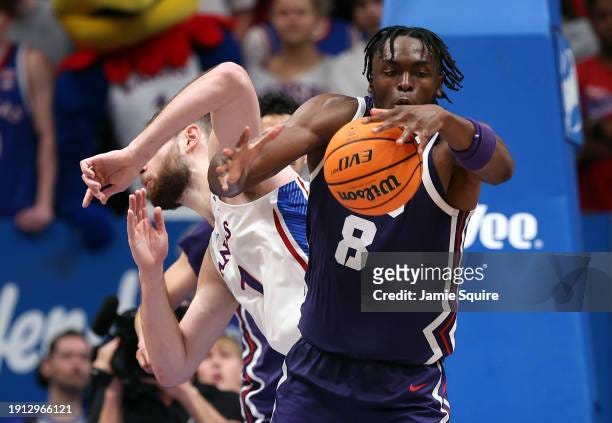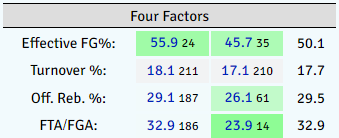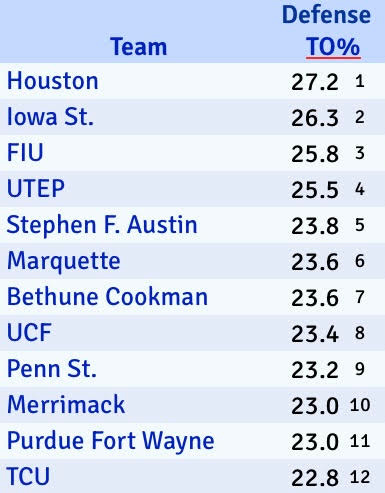Where Do We Go From Here?
A tenuous start to the Big 12 schedule for Kansas has raised questions about the ceiling of this year's team. What are some areas of concern and what are some reasons to remain optimistic?
While planning this newsletter, it felt like there was going to be an opportunity to write about how Kansas caught a break on Tuesday night with Houston losing to Iowa State, giving Kansas an early advantage in the Big 12 race. Less than 12 hours later, UCF knocked off Kansas 65-60 in a shocking result that took away any form of breathing room Kansas had gotten one night earlier.1 It’s still early in conference season, but the TCU and UCF results highlighted an area of concern that stood out even in non-conference play for this team: turnovers. Kansas is currently 211th in the country in offensive turnover rate and 187th in offensive rebound rate according to KenPom. If you aren’t getting extra opportunities on the offensive glass, you can’t turn the ball over on 18.1 percent of your possessions.
Kansas has turned the ball over 18 times in its first two conference games, a habit we saw repeatedly in non-conference play that felt like it would be cleaned up by this point. The biggest concern is that we’re seeing this consistently from the experienced players on the team. Whether Dajuan Harris is trying to force a pass through two defenders or Kevin McCullar is trying to dribble behind his back in the paint, there have consistently been low-IQ decisions from seemingly reliable players. Both players (along with K.J. Adams) are currently averaging career highs in turnovers. This could be due to the players feeling like they need to create more this season or from being tired due to lack of rest within games, but either way, this will need to be cleaned up in order for Kansas to reach its potential this season.
However, there is one major positive piece of information that comes out of Kansas’ first two games.
Both of Kansas first two conference opponents rank in the top 12 in the country in terms of defensive turnover percentage. In other words, their opponents turn the ball over on a higher percentage of their possessions than they would against an average team.23 Even though teams may rate higher in overall defensive efficiency, this is the one metric that stands out as a constant area of concern for Kansas when looking at matchups. For example, Tennessee’s defense is currently second overall in KenPom’s defensive efficiency ratings, but 79th in turnover percentage. Kansas did struggle slightly against them, but overall the offense ran much smoother. Kansas is 24th in the country in offensive effective field goal percentage, which means when they get shots, they make them at a higher rate than almost any other team in the country. If they can avoid turnovers, they’re a lethal offense to defend.
Unfortunately when you look at the table above, you notice that Houston and Iowa State are the top two teams. Kansas plays Iowa State on January 27th and Houston on February 3rd. This gives them two weeks to clean up the offense and focus on making cleaner decisions moving forward. Luckily, they have an opportunity to work through this in their upcoming games. This is where Kansas’ next four opponents rank in this metric:
Oklahoma - 100th
Oklahoma State - 218th
West Virginia - 341st
Cincinnati - 231st4
Other Thoughts from the First Two Conference Games
The “controversial” flagrant foul called on Ernest Udeh was the correct call. There was outrage across the country after the game, but it appears Udeh went to put his forearm into Hunter Dickinson’s chest to clear space and caught him in the chin. This is the same rule that’s applied on rebounds. If you are boxing a player out, throw an elbow back, and hit someone in the face, it’s considered a Flagrant 1 foul. Intent does not matter here. The rule states excessive force above the shoulders, and this fits that description. If he catches Dickinson in the chest, there isn’t a foul call and there’s a good chance Kansas loses their conference opener.
TCU’s Tennyson shot lights out against Kansas, and there’s nothing Kansas could have done to stop him. If anything, Tennyson and Tristen Newton’s performance in the Connecticut game should give Kansas fans a jolt of optimism. While it feels like there’s always a player who has a game like this against Kansas, the fact is teams need a player who plays the game of their lives to have a chance against Kansas. If Newton or Tennyson play to their normal levels, Kansas wins both games in decisive fashion. Players will obviously be amped to play against Kansas, and there will be more games like this in the future. It shouldn’t be seen as a shot at the team even though it’s frustrating for fans.
The Kansas offense has stretches where they are exceptional. Kansas closed out the TCU game by scoring on six of their last seven possessions. In the first half of the UCF game, Kansas scored on six of seven possessions in two different stretches in the first half. The bench minutes have created some issues with the flow of the offense, but the stretches where nothing happens on the offensive end need to be corrected. Johnny Furphy has provided an offensive spark off the bench, and Kansas will need this moving forward.
Speaking of Furphy, it was my personal opinion that he should have played more than Elmarko Jackson in the second half against UCF.5 Furphy felt more impactful and was a spark at the beginning of the game when Kansas was floundering. Bill Self has consistently played players throughout the season and had it work out later on in the year. Going to David McCormack in a close game early in conference play in the 2021-22 seasons paid dividends in the form of a basket that led to a national championship. There’s a chance Jackson makes plays in March due to what he experienced in the second half against UCF, but it felt like Furphy gave Kansas a better chance to win this game. However, I’ve learned to trust Self and had a friend point out that this second-guessing happens every year from Kansas fans, and Self is almost always validated by the time March rolls around.
For a team that needed desperately to avoid injuries, this past week has been rough. McCullar turned his ankle in the game against TCU. While he played against UCF, it felt like he wasn’t the same player we’d seen from him so far this year. Hopefully if there is an aggravating injury (which there probably is due to McCullar’s history), it’s minor and able to heal up from a few additional days of rest. After the UCF game, Self mentioned that Dickinson is dealing with a knee issue, which is part of what kept him on the bench for extended periods of time. Harris has taken a few knocks over the last few games as well, and stayed on the floor after a missed layup attempt in the second half against UCF. Kansas can’t afford to have any players out for an extended period of time this season much less their stars, so hopefully any injuries can be handled efficiently by the medical staff.
The Zone Layer
There was some discussion during and after the UCF game asking why teams hadn’t played more zone against Kansas prior to last night’s game. The answer is that Kansas had performed extremely well against zone defenses prior to last night’s game, and I’d argue the issue last night was one of lineups and not due to them facing a zone defense. Overall, Kansas ranks in the 95th percentile or “Excellent” per Synergy in points per possession against zone defenses. They’ve shot 61.8 percent against zone defenses with an effective field goal percentage of 75.0 percent. They’ve only turned the ball over on 13.0 percent of these possessions which is a lower rate than against man defenses.
At one point against UCF, Kansas was playing a lineup of Harris, Jackson, McCullar, Adams, and Parker Braun against the zone. They also played Harris, Jackson, McCullar, Furphy, and Adams for a stretch. They didn’t have Dickinson for a majority of the possessions the UCF played zone, and, if Harris and Jackson aren’t shooting or making 3’s, a zone defense without Dickinson on the court will be highly effective. When Dickinson is on the court and Harris is making open 3’s, a zone does little to stop what is usually a significantly efficient offense. Despite the lack of spacing provided by Adams, he works around the free throw and can make floaters from about 14 feet. In most situations, this would force a defender to commit to him, either bringing the center of the zone up and giving Dickinson space on the block, or causing one of the defenders to come off one of Kansas’ backside players giving someone an open look from the wing or corner. Adams has shown an ability to read the defense and make the right pass this season. This is where Jackson, Furphy, or Nick Timberlake need to be able to take and make open 3’s. Zone defenses haven’t been effective against Kansas until the second half of last night’s game. I’d expect to see some teams attempt to test out zone looks against Kansas, but Self will most likely spend some extra time ensuring the team is ready for the next time this happens.
This is arguably the most unexpected conference loss since the 2013 loss to TCU, which led to the infamous YMCA quip from Self.
Something else to note is Marquette is currently 6th in this metric, indicating that there is a specific type of team that this team struggles against.
Both TCU and UCF were top 15 before playing Kansas, so while their numbers did slightly improve after playin Kansas, they were already forcing turnovers at a high rate.
Cincinnati’s offensive rebounding will be a huge issue with the way Kansas has performed on the defensive glass.
This felt even more like the case when UCF went to a zone. Jackson’s refusal to shoot in the UCF loss was a significant step back from the player we saw against Wichita State, Missouri, and Connecticut.







